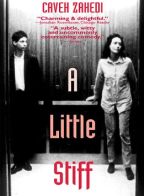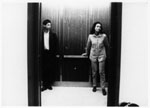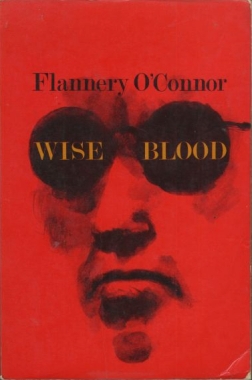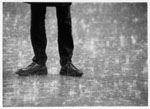From the Chicago Reader (September 6, 1991). — J.R.
A LITTLE STIFF
*** (A must-see)
Directed and written by Caveh Zahedi and Greg Watkins
With Zahedi, Erin McKim, Watkins, Patrick Park, Mike McKim, and Beat Ammon.
Minimalism seems to be getting a bad rep in some quarters these days, mainly from critics who identify that movement with the 70s and think that artistic styles should be up-to-date. But what if the artists themselves don’t identify with the overstuffed and unwieldy smorgasbords of 80s and 90s postmodernism? It seems to me that any serious assessment of minimalism has to consider what it manages to include as well as what it leaves out.
On both counts, Caveh Zahedi and Greg Watkins’s charming and delightful independent feature A Little Stiff, playing at the Film Center this weekend, beats what most commercial movies do with young romance hands down. Neither excessive nor undernourished, as its industry counterparts are prone to be, it strikes a happy balance. These filmmakers seem to know precisely what they’re doing every step of the way.
Minimal in budget as well as in style, form, and content — the entire production is said to have cost a mere $10,000 — this black-and-white 16-millimeter tragicomedy was shot by two UCLA film students chiefly on and around their own campus. Both filmmakers play themselves in the movie, as do all the other characters; the slender plot is a literal restaging of events that actually happened, with everyone re-creating his or her original role. A single subject — Zahedi’s unrequited love for, or infatuation with, Erin McKim over the space of what appears to be two or three months — is the focus of practically every scene and shot. The film’s minimalism is not merely the result of its limited number of settings, camera angles, characters, and dramatic situations but also of the limited number of emotions and behavioral patterns available to the characters.
The strengths of this concentrated approach are both comic and analytical; the results never stray from the recognizable and lifelike. The film’s multiple repetitions lampoon the monotony of romantic obsession and the monotony of a life-style that simultaneously supports and thwarts such an obsession. Caveh’s experimental film, which he shows to Erin and another character at one point, is a sort of objective correlative to this syndrome. It consists of endlessly repeated loops of different falls — an emaciated concentration-camp corpse is dumped into an open grave, a plane takes a nosedive, a prizefighter punches out an opponent, and a silent-film comic takes a pratfall. These are followed by animated drawings of the same actions, and all these loops are accompanied by the same musical fragments repeated over and over. The second short film of Caveh’s, which we see in production as well as in finished form, is nothing less than a staged repetition of his first encounter with Erin in the elevator — another instance of his repetition compulsion, in this case a miniature version of A Little Stiff itself. Given this obsessiveness, it’s hardly surprising that when Caveh receives a “climactic” phone message from Erin asking him to call back, he replays her message twice before he even thinks about complying.
Here are the principal repeated elements in the movie:
(1) Settings. Apart from a few privileged outings, these consist primarily of a bench outside a campus building where Caveh and Greg converse, always about Caveh’s love life; an elevator in one campus building, where Caveh first encounters Erin; the living room in Caveh’s apartment, where he places and receives phone calls; the seventh floor of a campus building, where Erin paints in a studio; a table outside one of the campus buildings, where Caveh and Erin are twice seen sitting. (The first time, they talk; the second time it’s raining, and he holds an umbrella while she writes, chiding him not to watch her.) Once we see a wide path leading from one of the campus buildings in an extended take from a fixed camera position — Caveh’s second encounter with Erin, when he asks if he can come see her paintings. Later, the film broadens this narrow repertoire to include Caveh’s bed, one room in Erin’s apartment, two rooms in her parents’ house, a small strip of southern California beach, and the dark interior of Erin’s car; each of these settings also appears only once.
(2) Camera angles. As often as possible, the film (shot by Greg Watkins) uses long shots, especially in exteriors and in the studio where Erin paints. Closer shots tend to be dictated by the size of the interiors, such as Caveh’s small living room and the elevator. The only outright close-up that springs to mind is of Caveh lying on his bed during a bad trip, after ingesting magic mushrooms. The medium-close shot of Caveh and Erin in the front seat of Erin’s car is so dark that it might as well be a long shot for all we can see in it. (It’s worth adding that answering-machine messages and the other sides of phone conversations in the film are aural equivalents to long shots — more overheard than heard, and far removed from the “foreground” of the sound track.)
(3) Characters. Apart from Caveh, Greg, and Erin, there are only two characters we see for any length of time: Richard and Patrick, two musicians who hang out on separate occasions with Erin and/or drop by Caveh’s apartment. The other characters — a few of Erin’s fellow art students, a few of Caveh and Greg’s fellow film students, and Erin’s father — are strictly cameos. And some of the fellow art students are merely voices heard faintly over the phone.
(4) Dramatic situations. These consist of Caveh encountering or looking for Erin, either over the phone or in person; Caveh discussing himself or Erin with Greg (usually in person, but sometimes over the phone); Caveh listening to music on earphones or, on one occasion, tripping alone; and Caveh encountering Richard or Patrick (the latter two either alone or with Erin).
(5) Emotions. In the opening scene, Caveh confesses to Greg that he can’t deal with uncertainty in relationships; as it turns out, uncertainty in his relationship with Erin is just about all he does have to deal with. In a subsequent conversation, when Caveh tells Greg that he’s in love with Erin, Greg suggests that “Love requires knowledge” and that what Caveh’s experiencing is infatuation. Caveh’s fleeting encounters with Erin are as apt to encourage as discourage him; he evaluates each of them at length with Greg. (Often the evaluations seem much lengthier than the actual encounters.) Rapture interlaced with pain and informed by self-absorption — epitomized by Caveh’s spastic gyrations to music heard over earphones — is the emotional state highlighted throughout; running a close second is a general state of confusion about how to proceed. (Erin, who’s frequently subject to nervous giggles, sometimes seems as confused as Caveh.)
(6) Behavioral patterns. The most blatant repetition in the film occurs when Caveh is seen on three separate occasions with a plant or flower of some kind — in long shot it’s hard to tell — that he’s attempting to deliver to Erin, each time finding that she isn’t in either one of the seventh-floor studios. Alternating with these scenes (filmed each time from the hallway) are phone calls to Erin placed from his living room in which he delivers three different messages to her answering machine — inviting her to go see a Bresson film, then to go see a Paradjanov film, and finally just asking her to call back. (Later, in person, he invites her to a Tarkovsky film — again without success.) Indeed, trying to find or reach Erin is Caveh’s main activity, followed by evaluating her responses and nonresponses with Greg’s help, trying to make small talk with her or her friends when he does find her, and trying to coerce a more committed response from her (when he calls her during his bad trip and later when he tells her he loves her).
Some of their mutual attempts at small talk are hilarious. “I like that color,” he says of a painting Erin’s working on when he visits her in her studio the first time. “It’s a bit like science fiction,” she says helpfully. “The color?” he asks. “The painting,” she replies. A little later, when seated with her on a bench while she describes her attempts to synthesize DMT in order to take it at the same time that a cat takes catnip, he lamely speculates that perhaps each drug only works for one kind of animal. Then he asks about this project, “Is this like a performance piece?” “Umm . . . well, yeah,” she replies, “but I’ll do it by myself.” Solo performance pieces without audiences are in fact this movie’s comic specialty — forlorn, uncertain messages on answering machines, manic gyrations to music over earphones, a solitary drug trip (undoubtedly inspired by Erin’s DMT-catnip project), an infatuation that borders on solipsism. Perhaps only the dialogues with Greg qualify as genuine exchanges; most of Caveh’s conversations with Erin proceed more like parallel monologues — like voices on answering machines playing phone tag.
When I met Caveh Zahedi at the Pesaro film festival last June, where he was showing A Little Stiff, I was surprised to hear him cite Woody Allen as one of his key models. It’s not that I doubt his sincerity, and in A Little Stiff he does play a short, ineffectual, Allen-style lovable schlemiel. But A Little Stiff exhibits a structural unity and purity of purpose that strike me as having considerably more integrity than the formal properties to be found in Allen’s comedies; the film also strikes me as a lot closer to the truth of life as it’s lived.
On the other hand, I fully acknowledge that this movie is limited — by its minuscule budget and the relatively small range of artistic choices such a budget allows, and perhaps even by the filmmakers’ shortsightedness. (In passing, however, it should be noted that the filmmakers were resourceful enough to use an animal trainer, listed in the credits — and a crucial performance by a squirrel does the trainer proud.) How, one may ask, can these limitations be considered advantages? Wouldn’t it have been better to have the same diverse, costly, and “professional” resources available to Woody Allen when he makes a movie?
I think not. Flannery O’Connor’s brief introduction to her first novel, Wise Blood, offers an essential clue as to why: “Does one’s integrity ever lie in what he is not able to do? I think that usually it does, for free will does not mean one will, but many wills conflicting in one man. Freedom cannot be conceived simply. It is a mystery and one which a novel, even a comic novel, can only be asked to deepen.”
Whether the integrity and unity of A Little Stiff is mainly a matter of what its authors are unable to do, or of what they choose not to do, is ultimately beside the point. What finally matters are the insights, the lived experience, the laughs and grimaces that result from the film’s unity and integrity. And we’re all much richer for them.






